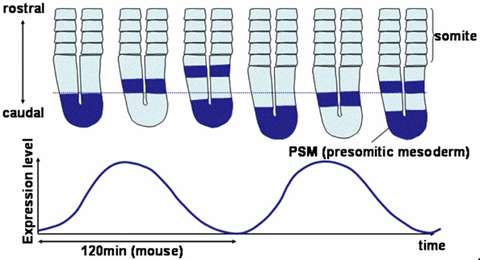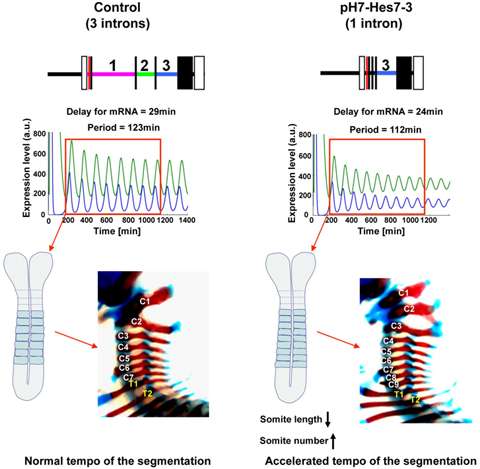Accelerating the tempo of the segmentation clock by reducing the number of introns in the Hes7 gene

Somites, precursors for the segmental structures such as the vertebral column, ribs and skeletal muscles, form periodically by segmentation of the rostral parts of the presomitic mesoderm (PSM). This periodic event is regulated by the somite segmentation clock, which is composed of Notch signaling molecules. In the PSM, the Notch components such as the basic helix-loop-helix gene Hes7 are cyclically expressed, and this cyclical expression leads to segmentation of a bilateral pair of somites (Figure 1). While Hes7 plays an important role in the segmentation clock, it was not known whether Hes7 is the fundamental pacemaker or whether it acts downstream of another oscillator.
The finding of the research team led by Professor Ryoichiro Kageyama and Doctor Course Student Ms. Yukiko Harima of the Institute for Virus Research was published in the journal Cell Reports.

It has been shown that Hes7 protein represses its own expression by directly binding to the Hes7 promoter (negative feedback). However, Hes7 protein is rapidly degraded by the ubiquitin-proteasome system, which allows the next round of Hes7 expression. In this way, Hes7 expression oscillates in the PSM. Mathematical modeling suggests that negative feedback with appropriate transcriptional/translational delays, which include transcription, splicing, translation and transport of mRNA and protein products, underlies the oscillatory expression, and that shorter delays would accelerate the tempo of but dampen the oscillation or abolish it. The research team hypothesized that if Hes7 is the fundamental pacemaker, the pace of the segmentation clock could be accelerated by reducing the number of introns within the Hes7 gene. The research team found that deletion of two introns within the Hes7 gene results in a more rapid tempo of both Hes7 oscillation and somite segmentation, increasing the number of somites and vertebrae in the cervical and upper thoracic region (Figure 2). These results indicate that the number of introns is important for the appropriate tempo of oscillatory expression, and that Hes7 is a key regulator of the pace of the segmentation clock.
More information: Yukiko, H. et al. Accelerating the Tempo of the Segmentation Clock by Reducing the Number of Introns in the Hes7 Gene, Cell Reports, 06 December 2012. dx.doi.org/10.1016/j.celrep.2012.11.012
Journal information: Cell Reports
Provided by Kyoto University

















